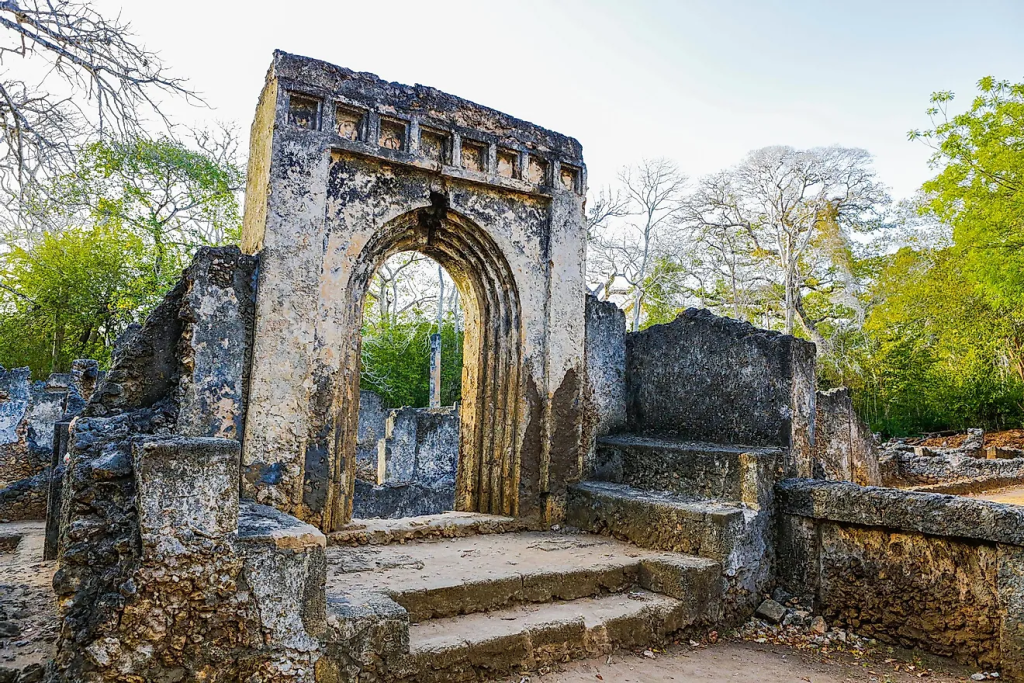The Gedi Ruins is an archeological and historical site found in eastern Kenya near the Indian Ocean in Kilifi County. It is approximated to be 16km South of Malindi town and 90km Noth East of Mombasa town. Gedi was built in the 15th century and occupies an area of 44 hectares of land.
It was built from rocks and stones and was inhibited by the Swahili people of East Africa. The town has been well preserved and therefore most of the original foundations can still be seen today. In 1927, the historic town was declared a historic monument.

The town was built due to the emigration of many citizens of Kilwa to coastal towns like Mombasa. There are many areas in the town that are distributed unevenly including the pillar tombs, numerous houses, the palace, and a great mosque. The pillar tombs are a distinctive type of Swahili architecture. The town became wealthy due to its numerous inhabitants and trading activities and it became one of the renowned towns in East Africa. The great palace and other things are evidence of its wealth.
Read: The Historic Town of Gedi
The town had two walls around it, the inner wall was where the rich lived while the outer wall was for the middle class. The outer wall also included plantation land and wattle houses for the middle class. The peasants lived outside the wall. In the 17th century, the families left the town. This was a result of a number of reasons including the removal of the Sheikh of Malindi, the Wazimba raid along the coast, and the emigration of the Portuguese to Mombasa.

Archeologists also suggest that the water table was growing significantly harder to reach due to depending on the one well, outside the mosque and there was also a deadly plaque. Gedi was then abandoned in the 17th century until 1894 when Sir John Kirk a British resident investigated the site, it began to get attention.
Read: INCREDIBLE HISTORY OF FORT JESUS FROM 1593
The indigenous forest surrounding ruins is still known as a sacred place where traditional rituals and sacrifices are conducted, for the surrounding community. They also say that the ruins are protected by the ‘old one’ who would curse anyone who will try to ruin the site. The forest has monkeys and butterflies. Guided tours will help you navigate the ruins as they explain the history in depth. The monument is managed by the National Museum of Kenya.

Entrance fee at The Gedi Ruins
Citizens pay ksh500 while tourists pay ksh1000
Opening hours
The monument is open to the public every day of the week from 7:30 am to 6:00 pm in the evening.
Attractions in Gedi Ruins
- Gede ruins- the mosques, palaces, houses and other structures like the pillar tombs are one of the most interesting things in the historical site.
- Arabuko-Sokoke Forest- this is a protected forest close to Gedi ruins that one can visit and experience a serene and tranquil environment. It is also home to the golden-ramped elephant shrew, owls, squirrels, and birds. The locals use the plants in the forest to make medicine.
- Kipepeo Butterfly House- this is a place in Gede that contains many species of butterflies and a guide takes you through the lifecycle and the beautiful transformation into a butterfly.
- A dated coral tomb– the tomb is dated 1399 with beautiful Arabic script.

A nature trail in the beautiful Gedi town is a must-visit for lovers of history or explorers. The tour guides offer a detailed history of the place and take you to the different places in the monument. Apart from Gedi ruins, there are many other must-visit places in the coastal region. Including the famous Fort Jesus, Watamu Island, Haller Park, Wild Waters, and old town.
The coastal food is also a must-try thing when visiting this side. The foods are mostly spiced and affordable. Examples of local foods are Shawarma, Biriani, and Viazi karai among others. A visit to the coastal region can never be boring. The presence of the beach, activities like boat riding, fishing, and a visit to the Samburu Nationa reserve make your visit more memorable.





